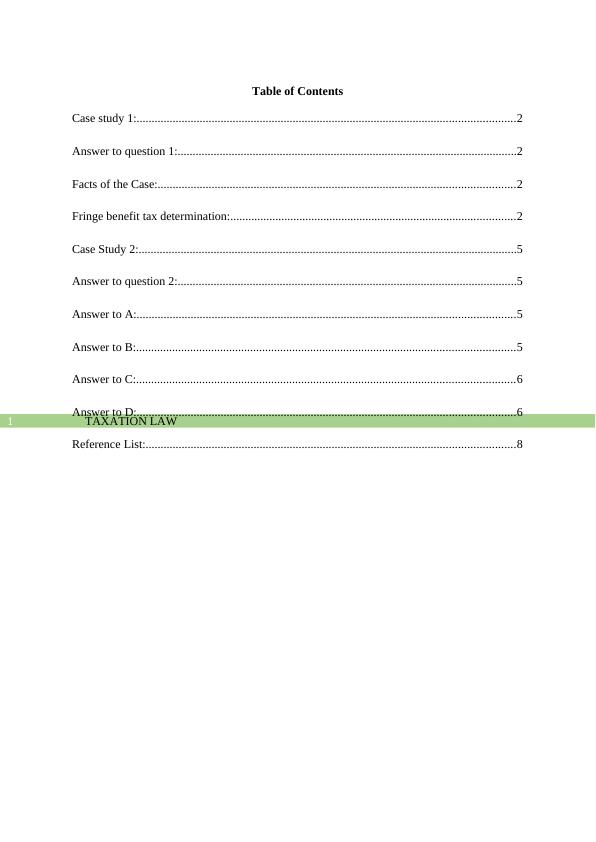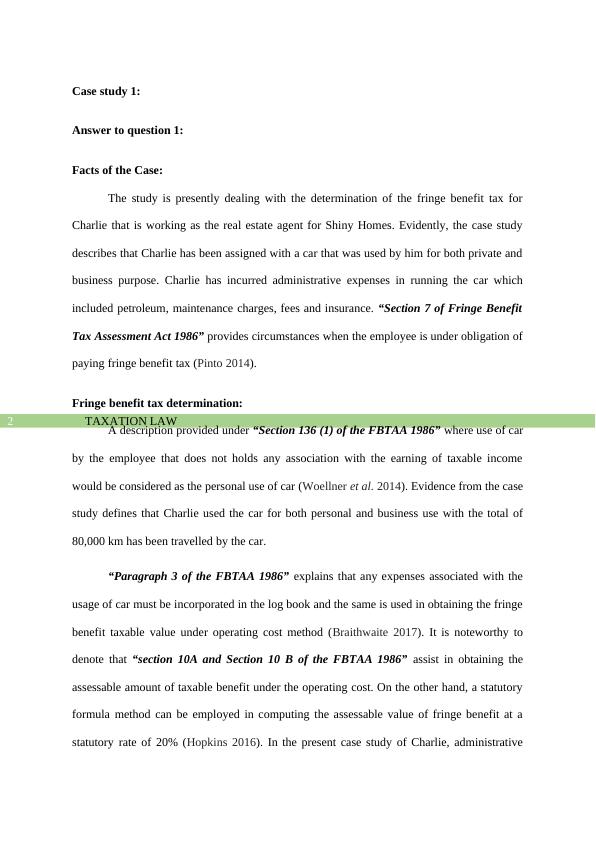Case Study - Taxation Law
Added on 2020-05-28
10 Pages1748 Words51 Views
Running head: TAXATION LAWTaxation LawName of the StudentName of the UniversityAuthors NoteCourse ID

TAXATION LAW1Table of ContentsCase study 1:..............................................................................................................................2Answer to question 1:.................................................................................................................2Facts of the Case:.......................................................................................................................2Fringe benefit tax determination:...............................................................................................2Case Study 2:..............................................................................................................................5Answer to question 2:.................................................................................................................5Answer to A:..............................................................................................................................5Answer to B:..............................................................................................................................5Answer to C:..............................................................................................................................6Answer to D:..............................................................................................................................6Reference List:...........................................................................................................................8

TAXATION LAW2Case study 1: Answer to question 1: Facts of the Case: The study is presently dealing with the determination of the fringe benefit tax forCharlie that is working as the real estate agent for Shiny Homes. Evidently, the case studydescribes that Charlie has been assigned with a car that was used by him for both private andbusiness purpose. Charlie has incurred administrative expenses in running the car whichincluded petroleum, maintenance charges, fees and insurance. “Section 7 of Fringe BenefitTax Assessment Act 1986” provides circumstances when the employee is under obligation ofpaying fringe benefit tax (Pinto 2014). Fringe benefit tax determination: A description provided under “Section 136 (1) of the FBTAA 1986” where use of carby the employee that does not holds any association with the earning of taxable incomewould be considered as the personal use of car (Woellner et al. 2014). Evidence from the casestudy defines that Charlie used the car for both personal and business use with the total of80,000 km has been travelled by the car. “Paragraph 3 of the FBTAA 1986” explains that any expenses associated with theusage of car must be incorporated in the log book and the same is used in obtaining the fringebenefit taxable value under operating cost method (Braithwaite 2017). It is noteworthy todenote that “section 10A and Section 10 B of the FBTAA 1986” assist in obtaining theassessable amount of taxable benefit under the operating cost. On the other hand, a statutoryformula method can be employed in computing the assessable value of fringe benefit at astatutory rate of 20% (Hopkins 2016). In the present case study of Charlie, administrative

End of preview
Want to access all the pages? Upload your documents or become a member.
Related Documents
Fringe Benefit Tax Assessment Act 1986lg...
|11
|2284
|34
Australian Taxation Law - PDFlg...
|12
|2448
|99
Taxation Law Assignment - Fringe Benefit Taxlg...
|8
|1309
|36
Benefits Tax Assessment Act 1986lg...
|13
|2290
|68
Fringe Benefit Tax Assessment Act 1986: Taxation Lawlg...
|12
|2130
|63
Answer to question 1: Taxation Law Name of the Student Name of the University Authorslg...
|12
|2450
|268
